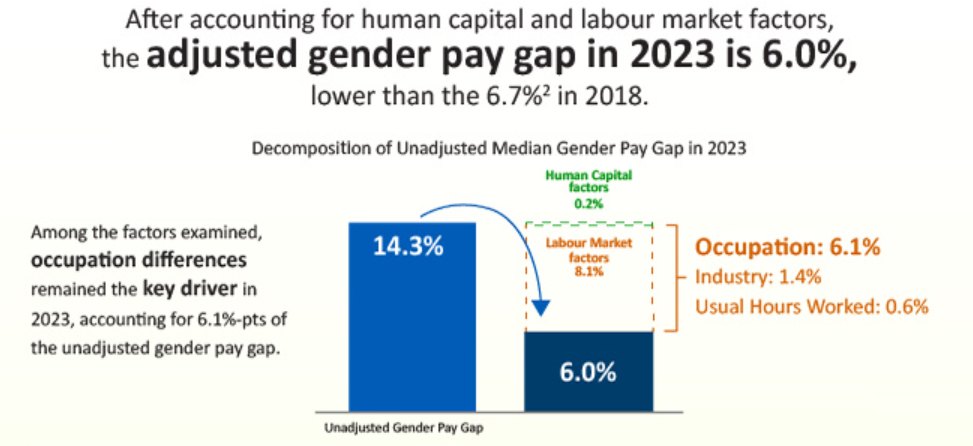“Why do girls always want guys to pay for them?”
Give chance lah. Odds are, your girlfriend probably makes less than you.
2023 Gender Pay Gap
The gender pay gap refers to the difference in the median income for female and male employees expressed as a percentage of the median income of male employees.
To provide updates on a study by the Manpower Research and Statistics Department (MRSD) of the Ministry of Manpower (MOM) and the National University of Singapore, the incomes of employees aged 25 to 54 who are Singaporean or permanent residents and working full-time were analysed.
The report found that the median income for women working in Singapore was 14.3% less than that for men in 2023. This is an improvement from 16.3% in 2018.
Singapore’s pay gap was slightly worse than that across Organisation for Economic Cooperation and Development (OECD) countries, which was 12.1% in 2022.
However, the OECD data also shows that Singapore did better than countries like the United States (17% in 2022), Britain (14.5%) and Japan (21.3%).
Differences in Occupation
MOM said that differences in occupation between men and women remained the key factor influencing the gender pay gap in 2023, among various factors examined.
One way this comes into play is where men are overrepresented in higher-paying occupations.
MOM, however, noted that from 2018 to 2023, the gender pay gap narrowed as the occupational profile of females improved more than that of men.
In 2023, 75% of women were working in professional, managerial, executive, and technician (PMET) jobs. This was an 8.8 percentage point increase from 2018.
On the other hand, the proportion of men in PMET jobs increased by only 6.3 percentage points in the same period, to 79.4%.
Looks like women are catching up to men in terms of being employed in PMET jobs.
Other Factors
I’m sure you’re thinking – aiya, of course if more men are in higher-paying jobs then there will be a wage gap, right? I want to know about the wage gap between men and women in the same job!
Other than occupation (6.1%), there were other labour market factors that contributed to the gender pay gap such as difference in industries (1.4%) and weekly working hours (0.6%). Human capital factors of age and education played a much smaller role (0.2%).
After removing the effects of occupation and other labour market and human capital factors, Singapore’s adjusted gender pay gap in 2023 was 6%, down from 6.7% in 2018.

So, yes, a woman could be working in the same job as her male colleague, in the same industry, at the same age and education level, but for lower pay.
Reader: Simi sai?
The report by MOM said that the adjusted gender pay gap – 6% in 2023 – could reflect the effects of parenthood, caregiving responsibilities, and unmeasured employment characteristics such as work experience, firm type, and job scope, as well as discrimination.
The adjusted gender pay gap has narrowed over time, from 8.8% in 2002 to 6% today.
A report in 2020 on the gender pay gap had stated the pay gap in 2018 as 6%, instead of 6.7%.
MOM explained that the model used to calculate it back then has since been revised using the latest occupational classification – the Singapore Standard Occupational Classification (SSOC) 2020.
SSOC 2020 is an update of the SSOC 2015 (Version 2018) edition.
Career Breaks
One reason that causes the pay gap to persist could be career breaks.
Salary should reflect one’s experience, expertise, job performance, and the contribution one can make to the role – all of which are linked to how long one is in the workforce.
Since women are more likely to take on primary caregiving responsibilities, they may need to take career breaks. This could “delay” work experience in the sense that while they are on their career break, they will not be accumulating more time in the workforce. This could then affect their salary accordingly.
National Service
Although this practice is becoming less common in the market, it is also worth noting that some organisations may even offer men higher starting salaries to compensate for national service.
This, in the long run, creates the pay gap.
Reader: Wow, even like that can one ah?
Women Feel They Are Not Being Compensated Fairly
A recent survey by Indeed suggests some women feel they are not being compensated fairly for work.
In November 2023, the job search platform polled 14,677 women in either full-time or part-time employment. The survey polled women in 11 countries, including 1,196 in Singapore.
The other 10 countries surveyed are: Australia, Canada, France, Germany, India, Italy, Japan, Netherlands, United Kingdom, and the United States of America.
The survey found that 37% of women in Singapore polled are most likely to consider the gender pay gap to be biggest in their country as a whole (rather than in their organisation or sector). This proportion, however, was the lowest out of 11 countries surveyed.
The global average figure was 57%, with Italy and France having the highest proportion of women – 70% and 68% respectively.
The survey found that 59% of women in Singapore feel they are not paid enough base salary, while 33% felt they were paid the right amount.
In spite of this, only a third of respondents here (32%) have asked for a raise during their careers. This is about half of the women who feel they are not paid enough.
The top reason cited was worrying about negative consequences (48%), while some said they either did not have enough confidence (34%) or did not think asking for a pay raise was an option (33%).
Of those who did ask for a pay raise, however, only three in 10 (of those in Singapore) received the pay raise they requested. 45% got a pay raise, but it was lower than the raise they requested, while 22% did not get a raise at all.
In terms of career progression, women in Singapore are in line with the global average in their belief that it is easier for men then women to progress in their careers. A total of 43% of women here felt that way.
Sexism or unconscious bias in society (56%) and caregiver responsibilities (54%) were the top reasons they cited for this perceived challenge.
In another survey done by recruitment firm Hays, it was found that 31% of Singapore workers felt that more needed to be done to ensure women had equal opportunities for workplace participation. This is higher than the Asian average of 19%.
This was based on a poll conducted last month among more than 500 workers.
Human resources (HR) experts noted that increased awareness and advocacy for diversity and inclusion at the workplace, as well as initiatives such as flexible work arrangements and programmes to encourage women to take up careers in STEM (science, technology, engineering and mathematics), have helped narrow the gender pay gap in Singapore. However, more can be done to tackle gender bias at work.
HR professionals should adopt a strategic approach to minimize gender-based pay gaps. It’s crucial that compensation reflects merit, skills, experience, and performance.
Employers could disclose pay structures within their organisations and include salary or salary ranges on job postings, said Indeed’s report.
They can also create a task force to foster diversity, equity, inclusion and belonging at the workplace, provide training on unconscious biases and provide mentorship and allyship programmes.



